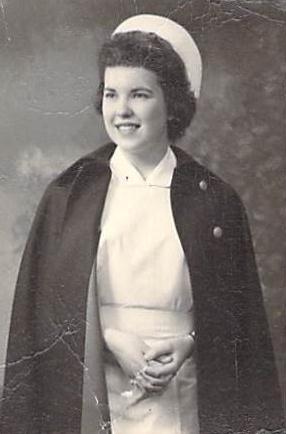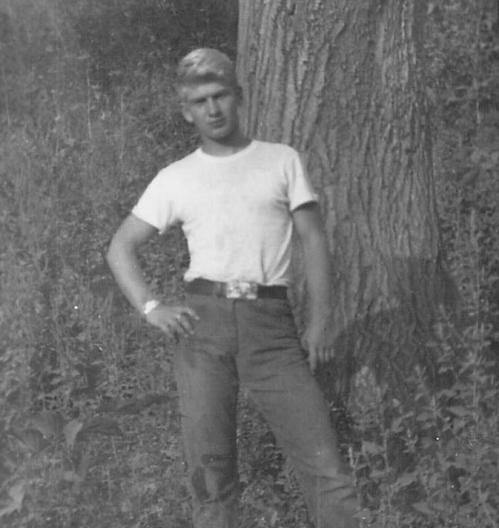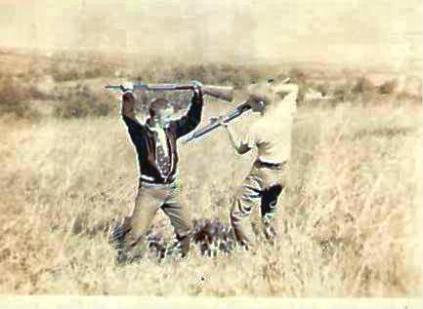
As a young child, I learned some Slovak from my Aunt Nana. Her parents had moved to the Lehigh Valley from Slovakia and handed that spirit of adventure on to me. I loved to be out on my own, exploring unknown territory. The oldest of four girls, I was a top student and spent my summers at Camp Moseywood. I always wanted to be a nurse; I became a good one.
At 27, I moved with Mike and our four little girls to Iran, eager for a new adventure. I learned some Farsi; we rented a house in north Teheran. Everything bought at the market had to be washed and soaked in bleach and water. Vendors walked through the alleys, crying their wares. The children clamored for camel rides. I took them to the Officer’s Club for swimming lessons and a host of activities. Our family enjoyed vacationing at the Caspian Sea.
Now I was moving in high society as a queen bee. Mike and I had two boys and another girl. I began teaching English to officers at Doshen Toppeh. For a mom with seven children, busy wiping noses and bottoms, it was nice to put on a clean outfit, work with grown-ups and be treated with respect.
In 1972 I began taking classes, long distance, through the University of Maryland. It was fun to take a class on “Politics of the USSR,” then go to a cocktail party and talk with ambassadors’ wives about politics and international relations. I was delighted to find I could hold my own; that really boosted my confidence.
Aunt Nana died while we were in Iran. One night, I woke up, elated, from a dream about her. One thing was clear; the lessons she’d learned from her family would be passed on to my children.
Slovakia, Pennsylvania, Iran: From One Generation To The Next
December 17, 2013
Family, friends, Imperial Iranian Air Force, Iran, Memoir, Middle East, military, nursing, Pennsylvania Leave a comment
From Hokendauqua To Hollywood
September 12, 2013
Iran, marketing, Memoir, Middle East, Pennsylvania, Uncategorized 6 Comments
Zebel, The Clever One, heads to Hollywood! Mike Roman’s book is being turned into a screenplay, highlighting selected scenes from the book along with new material never seen before. Now its time to finish up the script, check the beats, practice pitches and get everything ready in preparation for selling the screenplay. Sound like quite a gamble? So was moving a young family to a foreign country called Iran. Hollywood, here we come!
What Really Happened In Teheran That Day
April 12, 2013
Family, friends, Iran, Memoir, Middle East, Pennsylvania Argo, expatriate, Iran, mercenary 1 Comment
I went to see the movie Argo a few months ago. It was pretty boring, I thought. I mean, it was well-directed and edited; I know it won a lot of awards and all that. If you didn’t know the facts, you would have thought the movie was exciting. But all that really happened was, half a dozen US government employees sneaked out the back of the American Embassy on Takteh Jamshid Avenue and walked down the street to the Canadian Embassy. A few months later, an American agent got them out of the country. There was no shoot-out. It was disconcerting, too, seeing the scenes at the Embassy. I know it was really shot in Istanbul, but I was expecting to see the Hotel Caspian and other landmarks nearby. Naturally, since they couldn’t get permission to shoot in Iran itself, the exterior location shots weren’t that accurate.
Lucretia noted, the woman taking pictures as they walked through the bazaar — well, yeah, that was a real no-no. People wouldn’t like that. And it was true that they wouldn’t serve drinks on the plane until they were no longer over Iranian airspace. But everything else in the movie was over-dramatized.
Still, that’s what makes a good picture.
Barbara has started putting together the screenplay for Zehbel. Actually, I think she’s about halfway done. We have to get together and go over the scenes, to make sure everything is exactly right. The difference between Argo and Zehbel is, I’m a whole lot closer to the truth. And the truth, what I lived through during those ten years in Iran, is much more exciting than Argo.
I still miss all my wonderful friends back in Iran, but I have a good life here in Pennsylvania. And I’m grateful for that.
Dove of Truth
March 14, 2013
Family, Iran, Memoir, Pennsylvania Leave a comment
One morning I was standing by the big, six-foot windows in my living room, facing out over the meadow. It’s a beautiful scene: the wide open meadow surrounded by tall trees, a slight rise in the background. I had bought eleven acres and situated the house fairly close to the road, so we had all this open land behind the house for hunting and recreation.
Something caught my eye; there on the grass, close to the house, was a pure white dove. He was just standing there, looking at me. I think he was trying to tell me something. I watched him for about twenty minutes, standing there, steadily looking back at me, or at least facing in my direction.
I had been thinking about my book on Iran. There was a particular chapter I’d been mulling over, wondering if I should take out a certain phrase. You see, in the military, the language gets kind of rough sometimes. Guys act tough and come up with descriptive phrases to describe other guys. So, some military men would think this phrase was funny, but I didn’t think ordinary civilians would approve or understand. They might think it was a dirty word.
Then, this particular chapter described a certain lifestyle that was very common in Iran at that time. Should I tell the truth, or change it, so people wouldn’t be offended? Some people wouldn’t be happy, either way. What should I do?
That’s what was running through my mind as I stood there, drinking my tea and admiring the beautiful white dove. I wondered what he was trying to tell me. He certainly couldn’t talk; this wasn’t a Disney movie, after all. What could he mean, showing up in my meadow and staring at me so fixedly? A beautiful white dove, symbol of purity, like the Holy Spirit.
Purity and holiness, attributes of God, the Blessed Trinity, and the Blessed Virgin Mary.
Hmmm. I suddenly realized what the dove meant. I took out the phrase; it didn’t really need to be there after all. But then, I left the rest of the chapter alone. I let the truth remain.
Sacred Heart Nursing School, Allentown, PA
March 9, 2013
Family, friends, Memoir, Pennsylvania 3 Comments
 In 1912 the Missionary Sisters of the Most Sacred Heart came to Allentown, PA . They moved into a working class neighborhood and started caring for the poor. Allentown, at the time, was suffering from a serious outbreak of diphtheria. The nuns nursed people back to health. Slovak immigrants began flooding into the area, working in the coal mines. Some of the nuns began teaching the Slovak children.
In 1912 the Missionary Sisters of the Most Sacred Heart came to Allentown, PA . They moved into a working class neighborhood and started caring for the poor. Allentown, at the time, was suffering from a serious outbreak of diphtheria. The nuns nursed people back to health. Slovak immigrants began flooding into the area, working in the coal mines. Some of the nuns began teaching the Slovak children.
I was accepted into Sacred Heart Nursing School in Allentown right after graduating from Central Catholic High School. I always knew I wanted to be a nurse; this was my dream. I had just turned 18, so my parents were able to cash in an insurance policy they’d purchased for me as a baby.Some of that helped towards the $300 I needed for my first year. We apparently weren’t eligible for a scholarship from Sacred Heart. The school only gave out one scholarship for the year, and another student got it. She had more brothers and sisters than I did. Anyway, I got through that first year.
Sr. Antoinette Martinko was a Franciscan nun, German, very strict, and very smart. She was tall, well-built but not heavy, maybe 5’9.” She wore black rimmed glasses; I would guess she was in her mid 50s when I attended Sacred Heart Nursing School in 1957-1960. Sr. Antoinette was head of the whole hospital, and the nursing school. She was the last word.
I know everyone was scared of her. She just instilled that feeling of being unapproachable. But one day, I had to see her. She called me into her office and questioned me about working at Camp Moseywood. I had been helping out the camp nurse that past summer, and Sr. Antoinette felt that violated some code. Sacred Heart nursing students weren’t supposed to work in nursing until they graduated. I didn’t think helping out at the camp was really nursing. I made myself speak up to Sr. Antoinette; I felt I had to put myself on the line. I think she respected that. I didn’t tell anyone except my mom, but I was so relieved when she decided to let me stay on in the nursing program. She really cared about her nurses. The Sacred Heart nurse was THE nurse, to her. She was very proud of her nurses; any misbehavior was unacceptable.
She policed our dorms. We were housed in a red brick building right next to the hospital. We had to live there; we could not go home. There was an underground entrance into the hospital itself. We ate at the hospital and our classes were there. Some doctors taught us, and some German nurses. They were all very strict. I think they were recruited right from Germany. The one who taught microbiology had a very thick accent but she knew her stuff. She was like a super-nun, really way ahead of her time. There is so much she taught us that I still remember and I put it all into practice. She talked about cancer and how cells grew. Wow, what an education.
We wore a blue, long-sleeved dress, then a big, pale blue starchy apron down to our ankles. There was a bib buttoned onto the skirt, very starchy. It tied to our waist. The collars were separate. Then, there was a white cap too. Your shoes had to be polished. If you did not present yourself like you were supposed to, Sr. Antoinette would take you down. Hair had to be a certain length or pulled back into a bun. We had a white Sacred Heart cap. We were capped the first year, after six months, then we got a beautiful dark navy blue cape with a red lining. We didn’t go out on the floor until six months; before that we were in the classroom.
The next summer, before my second year, again I needed money to pay for school. What could I do? I was determined to finish nursing school; nothing was going to stand in my way. So I found the local military recruiting station and applied to go into the Army, like Mike. The recruiter said “yes you can join. Finish nursing school and then you’ll be a second lieutenant.”
Sr. Antoinette heard about my plans. To this day, I have no idea how she found out. Again, she called me into her office. She said “no Sacred Heart nurse is going to join the military. I will give you the money and you will pay me back.”
In 1960, 60 nurses graduated from Sacred Heart School of Nursing in Allentown PA. I was one of them.
I would pay Sr. Antoinette $20 dollars or so from every paycheck. When I got married I still owed her $150. I paid that off. I had a guaranteed job with Sacred Heart Hospital and it was worth every penny. My dream had come true.
A Sacred Heart Nurse, 1960
March 3, 2013
Family, marketing, Memoir, nursing, Pennsylvania family, Imperial Iranian Air Force, Iran, memoir, mercenary, Middle East, nursing, USAF Leave a comment












